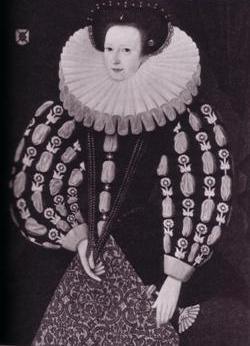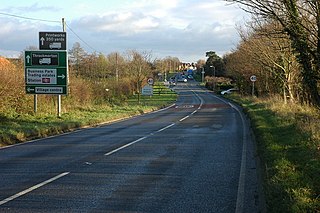
Walter Devereux, 1st Earl of Essex, KG, was an English nobleman and general. From 1573 until his death he fought in Ireland in connection with the Plantations of Ireland, most notably the Rathlin Island massacre. He was the father of Robert, 2nd Earl of Essex, who was Elizabeth I's favourite during her later years.
Margaret of Norfolk or Margaret of Brotherton, Duchess of Norfolk in her own right, was the daughter and eventual sole heir of Thomas of Brotherton, eldest son of King Edward I of England by his second marriage. In 1338, she succeeded to the earldom of Norfolk and the office of Earl Marshal. In 1397, she was created Duchess of Norfolk for life.

Henry Scrope, 3rd Baron Scrope of Masham KG, also known in older sources as Lord Scrope was a favourite of Henry V, who performed many diplomatic missions. He was beheaded for his involvement in the notional Southampton Plot to assassinate the king. Some historians believe that the charge was trumped-up to punish him for other acts of disloyalty, and that there may never have been such a plot.

Robert Rich, 3rd Baron Rich, 1st Earl of Warwick, was an English nobleman, known as Baron Rich between 1581 and 1618, when he was created Earl of Warwick. He was the first husband of Penelope Devereux, whom he divorced in 1605 on the grounds of her adultery.

Edward Arden was an English nobleman and head of the Arden family, who became a Catholic martyr.
Joan Holland was the third daughter of Thomas Holland, 2nd Earl of Kent, and Alice FitzAlan. She married four times. Her first husband was a duke, and the following three were barons. All of her marriages were most likely childless.

Lady Anne Hastings, Countess of Huntingdon was an English noble. She was the daughter of Henry Stafford, 2nd Duke of Buckingham, and Catherine Woodville, sister of queen consort Elizabeth Woodville. She was first the wife of Sir Walter Herbert and then George Hastings, 1st Earl of Huntingdon, and served in the household of King Henry VIII's daughter, the future Queen Mary I.

Elizabeth de Vere, Countess of Oxford was an English noblewoman. As a young child she became a royal ward.
William Conyers, 1st Baron Conyers, also known as William Conyers of Hornby, was an English baron and aristocrat.
Alice of Norfolk or Alice of Brotherton was an English noblewoman. She was the daughter of Thomas of Brotherton, and a granddaughter of King Edward I of England. She married Edward Montagu, 1st Baron Montagu.

Anne Morgan, Baroness Hunsdon was an English official. She was the wife of Henry Carey, 1st Baron Hunsdon, by whom she had a total of 13 children. On 14 December 1595, she was appointed by Queen Elizabeth I of England to the office of Keeper of Somerset House; a post which she held for life. She also served the Queen as a Lady of the Privy Chamber.

Sir Bryan Stapleton KG was an English medieval knight from Yorkshire.

Edward North, 1st Baron North was an English peer and politician. He was the Clerk of the Parliaments 1531–1540 and Lord Lieutenant of Cambridgeshire 1557–1564. A successful lawyer, he was created the first Baron North, giving him a seat in the House of Lords.

Henry FitzHugh, 3rd Baron FitzHugh KG of Ravensworth Castle in North Yorkshire, was an administrator and diplomat who served under Kings Henry IV and Henry V.
Sir Thomas Parr was an English landowner and elected Member of Parliament six times between 1435 and 1459. He was great-grandfather of Queen Catherine Parr, the sixth wife of King Henry VIII.
Ralph Eure, 3rd Baron Eure, of Ingleby and Malton, Yorkshire, was an English nobleman and politician. The surname, also given as Evers, was at that time probably pronounced "Ewry".

William Willoughby, 5th Baron Willoughby de Eresby KG was an English baron.

William Neville of Penwyn and Wyke Sapie, Worcestershire, was the son of Richard Neville, 2nd Baron Latimer, and the author of The Castell of Pleasure. In 1532 he was accused of treason and dabbling in magic.

Sir Thomas Tuddenham was an influential Norfolk landowner, official and courtier. He served as Steward of the Duchy of Lancaster, and Keeper of the Great Wardrobe. During the Wars of the Roses he allied himself with the Lancastrian side, and after the Yorkist victory in 1461 was charged with treason and beheaded on Tower Hill on 23 February 1462.
Sir Thomas Perrot was an Elizabethan courtier, soldier, and Member of Parliament. He campaigned in Ireland and the Low Countries, and was involved in the defence of England against the Spanish Armada. He was imprisoned several times, on one occasion to prevent a duel with Sir Walter Raleigh, and on another occasion because of his secret marriage to Dorothy Devereux, a Lady-in-waiting to the Queen, and sister of the Queen's favourite, the Earl of Essex. Perrot's only daughter, Penelope, married Sir Robert Naunton, author of Fragmenta Regalia, which claimed that Perrot's father, Sir John Perrot, was an illegitimate son of Henry VIII.













